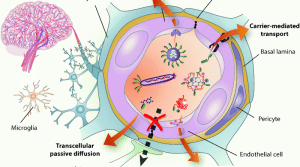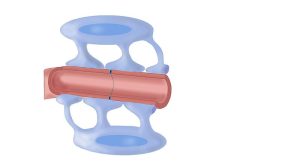The Blood-Brain Barrier
Jim Hutchins
Objective 4: Illustrate the blood-brain barrier (BBB).

The brain tightly regulates which substances are allowed into the CNS. The blood-brain barrier (BBB) is a collaboration between the lining of capillaries and the end-feet of astrocytes. It keeps most substances in the bloodstream from entering the brain. There are pumps to bring glucose, some amino acids, and water into the brain. Lipid-soluble molecules can pass through simple diffusion. Waste products are pumped from the brain into the blood. Everything else is kept out, unless the brain is diseased.
One exception is the area postrema, also called the “vomiting center.” This small area of the medulla oblongata has no blood-brain barrier, which gives it access to any toxins or irritants which might be circulating in the blood. If it detects them, then it triggers emesis (vomiting) through the nearby vagus nerve.
The BBB is nice to have, but one problem is that it can keep out drugs (particularly antibiotics) that we might want to use to help a patient. It is important to design drugs to be used in the brain so that they can circumvent this barrier. For example, if a bacterium penetrates the blood-brain barrier, it can be difficult to deliver antibiotics to the area of infection.
Media Attributions
- Drugs and blood brain barrier © Díaz-Perlas, Cristina; Oller-Salvia, Benjamí; Sánchez-Navarro, Macarena; Teixidó, Meritxell; & Giralt, Ernest is licensed under a CC BY-NC (Attribution NonCommercial) license
- Blood Brain Barrier © Sykepleiepluss.com is licensed under a CC BY-SA (Attribution ShareAlike) license
- Meninges BBB © NIH Medical Arts is licensed under a CC BY-NC (Attribution NonCommercial) license

